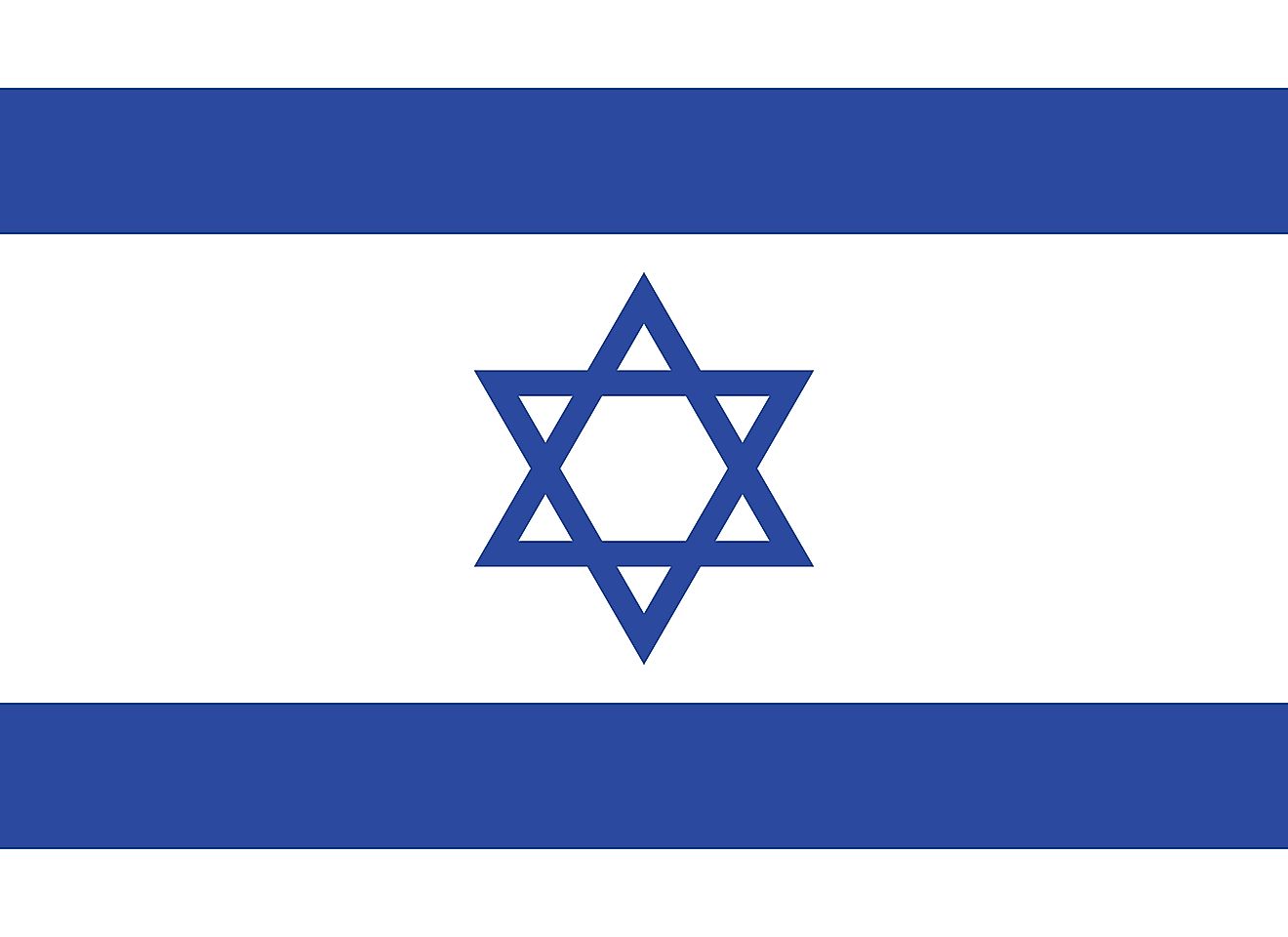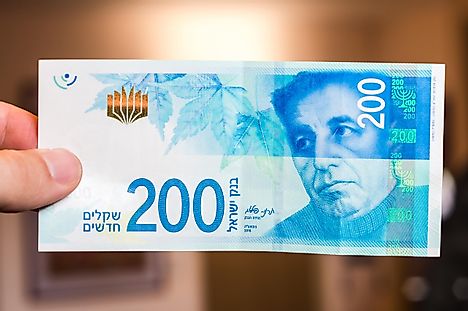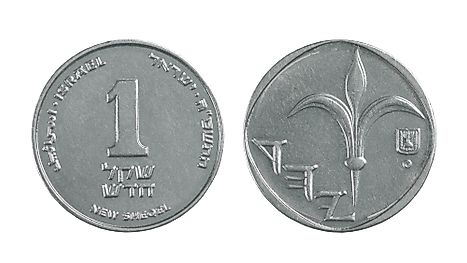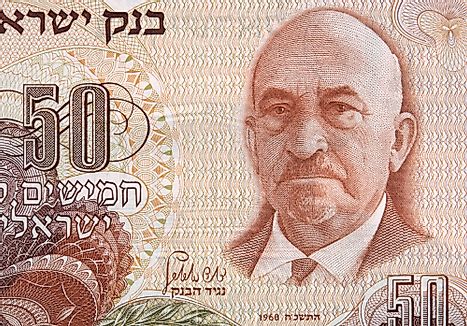Flags, Symbols, & Currencies of Israel

The flag of Israel was officially adopted on October 28, 1948, just about five months after Israel was established. It displays one of the most recognized symbols in the world - the Star of David - long associated with the Jewish people.The flag of Israel consists of white band with a blue hexagram (six-pointed linear star) known as the Magen David (Star of David or Shield of David) centered between two equal horizontal blue bands near the top and bottom edges of the flag. The basic design resembles a traditional Jewish prayer shawl (tallit), which is white with blue stripes. The hexagram, as a Jewish symbol, dates back to medieval timesIsrael. According to the Israeli laws, the flag should meaure 160 by 220 cm, giving it a proportion of 8:11.
Since Israel is a nation with a Jewish majority, symbols of Judaism are represented on the flag. The flag's basic design is based on the tallit, which is a fringed garment made of white cloth with black or blue stripes, and is traditionally worn by religious Jews. Therefore, the blue stripes and white field of Israel’s flag represent the stripes on the tallit. The Star of David, which is one of the main symbols of Judaism, is also featured on the flag. In Judaism, blue symbolizes God's purity, glory, and severity, while white symbolizes Divine Benevolence (chesed)
History of the Flag of Israel
Five months after the establishment of the independent state of Israel, the country adopted its national flag. According to state legislation, the flag’s official dimensions are 160 × 220 cm and its proportions are 8:11. The flag was first designed during the 1891 Zionist Movement. In 2007, a flag of Israel measuring 2,170 ft × 330 ft and weighing 5.2 tonnes was displayed near Masada, an ancient fortress associated with Jewish history. The flag became the world’s largest flag, breaking all previous records.
Symbols of Israel
National Coat of Arms of Israel

The emblem of Israel consists of a blue shield depicting a menorah surrounded by olive branches on both sides. The writing, "ישראל" (Israel), is inscribed below the menorah. The menorah depicts the Arch ot Titus' menorah and symbolizes universal enlightenment, and the olive branches represent peace. The emblem was adopted after a competion held in 1948. The winning design was submitted by Gabriel and Maxim Shamir.
National Anthem
- Anthem Title: Hatikvah
- Music composer: Bedrich Smetana
- Lyricist: Naftali Herz Imber
- Date of Adoption: 2004
The Hatikvah (The Hope) is Israeli's national anthem and a 19th-century Jewish poem. The first version of the song was composedin 1877 by Naftali Herz Imber as a reflection of hope of the restoration of the Land of Israel. The anthem was first adopted in 1897 by the first Zionic Congress and again provisionally by the new state of Israel in 1948. However, Hatikvah was officially adopted as the national anthem of Israel in 2004.
Hatikvah (Hebrew)
כֹּל עוֹד בַּלֵּבָב פְּנִימָה
נֶפֶשׁ יְהוּדִי הוֹמִיָּה,
וּלְפַאֲתֵי מִזְרָח קָדִימָה,
עַיִן לְצִיּוֹן צוֹפִיָּה;
עוֹד לֹא אָבְדָה תִּקְוָתֵנוּ,
הַתִּקְוָה בַּת שְׁנוֹת אַלְפַּיִם,
לִהְיוֹת עַם חָפְשִׁי בְּאַרְצֵנוּ,
אֶרֶץ צִיּוֹן וִירוּשָׁלַיִם.
The Hope
As long as in the heart, within,
The soul of a Jew still yearns,
And onward, towards the ends of the east,
an eye still gazes toward Zion;
Our hope is not yet lost,
The two-thousand-year-old hope,
To be a free nation in our land,
The land of Zion and Jerusalem.
The Currency of Israel is the Israeli new Shekel
The currency of Israel is the Israeli new shekel. The Israeli new shekel is coded as ILS, and was formerly known as New Israeli Sheqel (NIS). The Israeli new shekel is symbolized by ₪, which is a combination of the signs of two Hebrew words: shekel and hadash. Besides its use within Israel, the Israeli new shekel is also used as legal tender in Palestinian territories, including the West Bank and the Gaza Strip. The new shekel is subdivided into 100 agora. The body responsible for the issuance of the new shekels is the Bank of Israel. According to Bank of Israel, the inflation rate of the new shekel was -0.2% in 2016.
Coins
The first coins were produced in denominations of ₪1/2 and ₪1, and 1, 5, and 10 agora in 1985. This was followed by the introduction of ₪5, ₪10, and ₪2 coins in 1990, 1995, and 2007 respectively. In 1990, the production of the 1 agora coin stopped, and the 5 agora coin was removed from circulation in 2006.
Banknotes
Israeli new shekel banknotes have been issued in three stages since 1986. Introduction of the first notes was done through a Series A issuance between 1985-1999. In 1985, new shekels of denominations ₪5 ,₪50, and ₪10 were issued. This was followed by the introduction of ₪1 and ₪100 in 1986, ₪20 banknotes in 1988, as well as the ₪200 in 1991. Eventually, banknotes in ₪1, ₪5, and ₪10 denominations were replaced by coins. The Series B note issuance began in 1999, and in 2005, these Series B notes replaced the first series banknotes. Denominations of notes issued at the time were ₪20, ₪50, ₪100, and ₪200. The Series C notes issuance occurred from 2014 to date, and has incorporated the English word for shekel. The Bank of Israel previously used the Hebrew words shaqim and sheqel, not shekel. The new notes also bear portraits of Israeli poets such as Leah Goldberg, Rachel Bluwstein, Nathan Alterman, and Shaul Tchernichovsky. Current denominations of Israeli new shekel banknotes include ₪20, ₪50, ₪100, and ₪200.
History of the Shekel
The name “shekel” is derived from an ancient biblical reference to a currency of the same name. The first currency was issued when Israel attained its independence in 1948, and was referred to as the Palestine pound. Later, the name was changed to the Israeli pound in 1952. The Israeli government stopped fixing the value of the Israeli pound to the British pound in January 1954. In the following year, Israel established the Bank of Israel. Subsequently, in 1980, the name of the Israeli currency changed from Israeli pound to the old shekel. The shekel experienced hyperinflation during the 1980s, and as a result, was replaced by the new shekel on January 1, 1986, following various monetary policy adjustments. These conservative and careful monetary and fiscal policies have resulted in Israel’s positive balance of payments. Furthermore, the Israeli new shekel has become stronger against the US dollar. The currency is a fully convertible and can be traded in futures contracts in the foreign exchange market.
Historical Currencies of Israel
Before Israel adopted the use of shekel, the state's currency was Israeli pound (lira yisraelit). This currency was used between June 1952 and February 1980. The Israeli pounds were the first banknotes minted by the Bank of Israel established in 1955. The currency consisted of only Hebrew writing and the symbol "I£." The Israeli Pound was initially pegged on British pound, but the pegging was dropped in January 1954. A public debate in the 1960s led to the remova of the non-Hebrew name and replacing it with the name "Shekel." The new name came into effect in February 1980 when the government changed the monetary system. The old shekel was used from February 1980 to December 1985.














